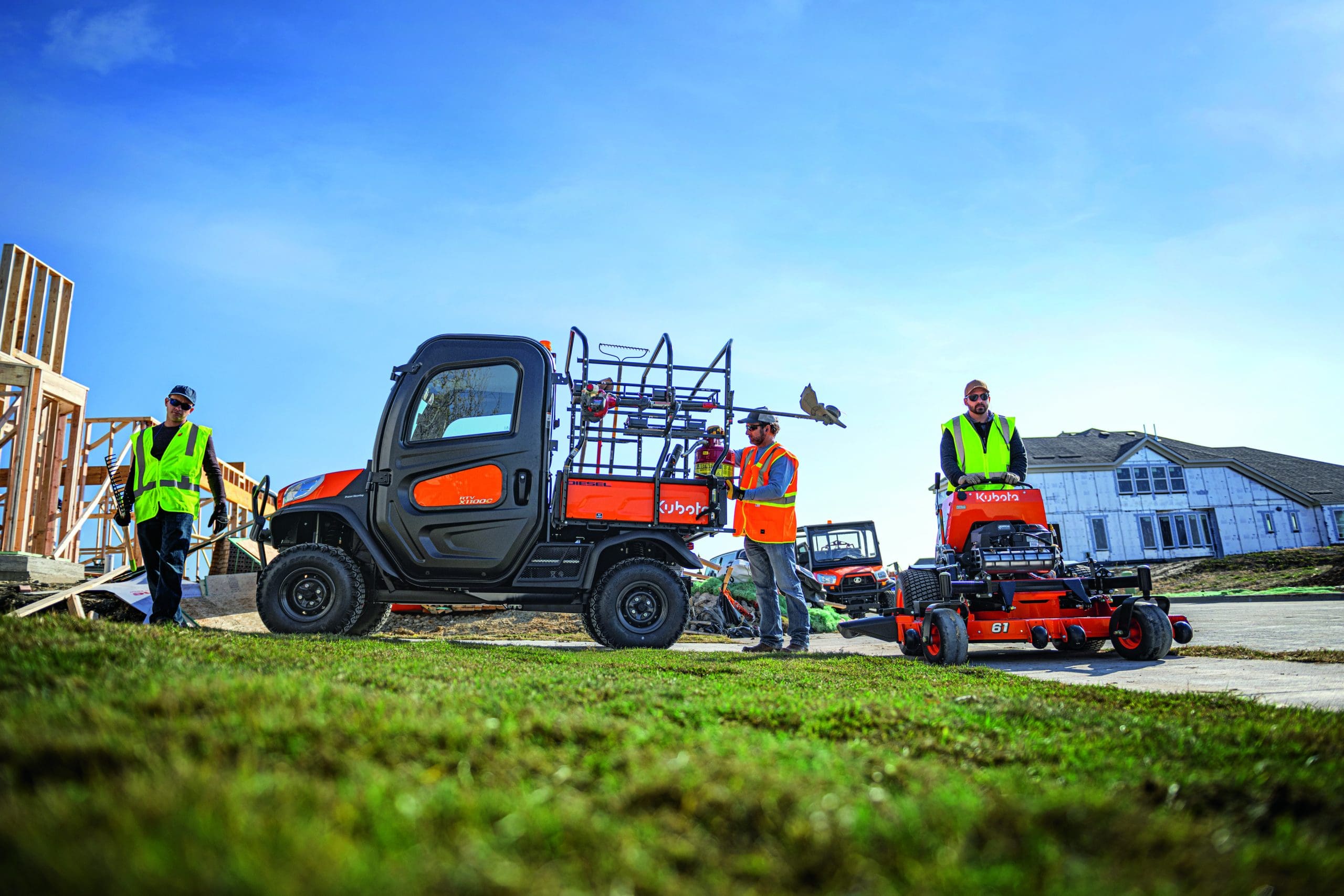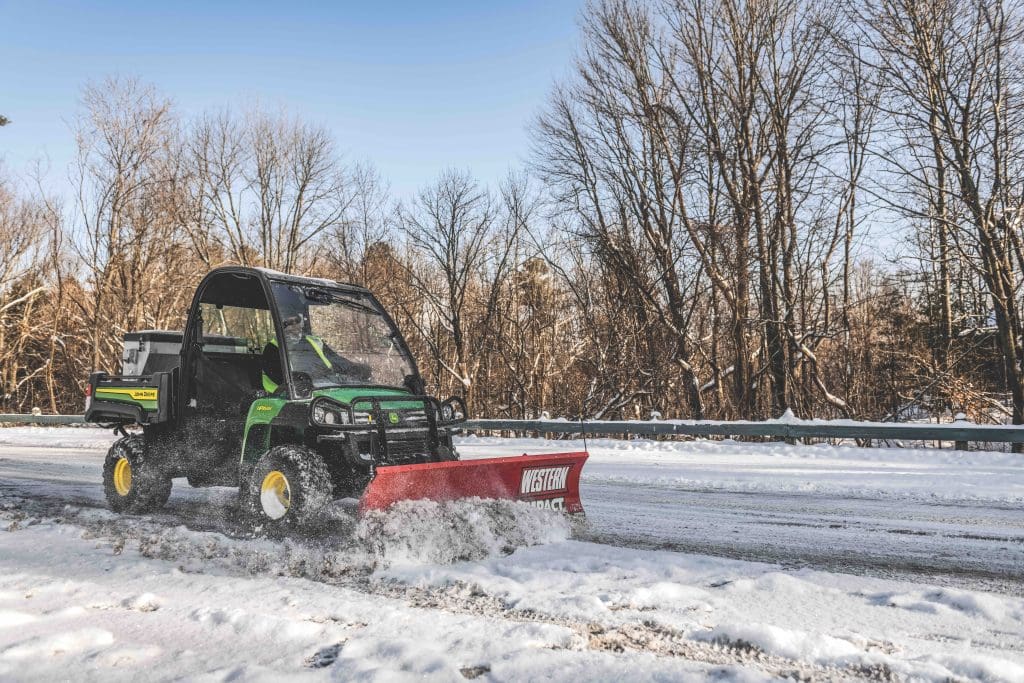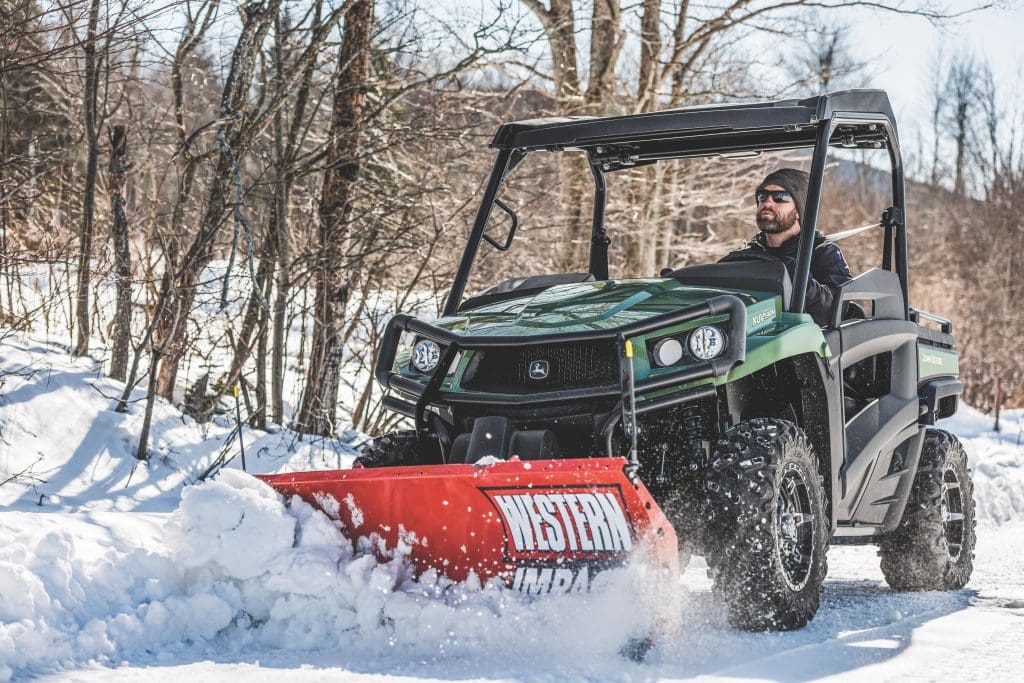
Versatility and productivity are two ideal traits when it comes to equipment in the landscape industry and UTVs are able to deliver on both.
“I think more and more landscape professionals are seeing the benefits of having a UTV in their fleet,” says Maureen McCormack, go-to-market manager for Gator Utility Vehicles for John Deere. “They can quickly haul mulch or dirt or sand or rocks to wherever it’s needed. They can also drop off or pick up their crew members and any tools or supplies they may need at those less accessible areas of the properties that they’re maintaining.”
Uses of UTVs
UTVs can serve numerous purposes, including transporting people, towing, hauling materials and adding attachments to snowplow or blow debris.
McCormack says that UTVs are a great way for landscapers to save time and move materials efficiently, especially on large properties like office complexes, college campuses or parks. She says they’re also ideal for contractors transporting heavy material on a tight property.

“A lot of the time when you’re thinking about college campuses or large office complexes, you may have to drive all the way around in a pickup truck to be able to get to the far side of the property,” McCormack says. “But with a utility vehicle, you can usually take a little more direct route across the campus or across the office complex or sports field.”
Kiara Daniel, product manager of Rough Terrain Vehicle (RTV) accessories for Kubota Tractor Corporation, says that while landscape professionals may be aware of the base UTV, they may not be as familiar with the versatility and capabilities of all the attachments available.
Per Kvarby, VP of marketing for Greenworks Commercial, notes that with the emergence of battery power and more clients pushing for sustainable solutions, electric UTVs will become more attractive in the eyes of landscape professionals and there will be a faster pace of growth.
“We see a growing need, especially for larger estates and lots of properties, to transport both materials and people and that’s where I think UTVs, particularly battery-powered ones, have become a great tool for landscapers,” Kvarby says.
What Features to Consider
When shopping for a UTV, what specs matter and which features aren’t as critical depends on your specific needs.
“Landscape professionals and any customers in the market for a new UTV/RTV should first understand how they plan on using the vehicles,” Daniel says. “Will it be just hauling people and materials, towing, mowing, raking, snow removal, etc. Then they can decide on the most important features and how the units stack up to their desired usage and benefit.”
She says landscapers should consider the UTVs’ durability, versatility, and attachment/implement offerings. Kvarby adds towing capacity, cargo bay capacity and the type of drive train are other features to consider.

McCormack says landscape professionals also need to think about if they’ll be driving on mostly paved surfaces or turf. While UTVs with aggressive tire treads look cool, they’ll tear up grass if the operator isn’t careful. She suggests more of an all-terrain tire if driving on grass a lot.
“They also want to look for vehicles that have a tight turning radius because there’s a big difference in between vehicles and how tightly they can turn,” McCormack says. “You want something that has a tight turning radius so you don’t have to back up and go forward and do a six-point turn to get into tight space.”
She says power steering also is a huge difference for operators, making the UTV easier and more comfortable to drive. She adds that features like a roof or an air-conditioned cab can make team members’ lives easier.
“It’s hard to find people and it’s hard to keep people right now,” McCormack says. “There’s a labor crunch perpetually in the landscaping industry. So anything you can do to make the job easier for your crew, and to make them a little more comfortable throughout the day might help them stick around a little more.”
McCormack suggests looking at what your dealer can offer you overall and finding a dealer who is able to provide a full breadth of product offerings, as they are going to be able to serve you better than a power sports provider in addition to your lawn equipment dealer.
Some features to avoid getting distracted by include aesthetics, speakers, and speed. McCormack points out that while some UTVs can go 60 mph, landscape contractors should focus on models with a lower speed range for safety.
“It really becomes a matter of knowing what your needs are and how that translates into features of a UTV,” Kvarby says. “You don’t want to pay for features that you’re not going to use.”
Electric Models and Attachments

McCormack says choosing an electric UTV model is also a major consideration as more contracts call for all electric equipment, especially on larger campuses where the vehicle would be useful.
“I do feel like there will be an increased demand for electric UTVs as the green industry becomes more ‘green’” Daniel says. “As the fleets start to convert from fuel to electric, and regulations/requirements/restrictions are put in place, the demand will increase. I do not think that gas and diesel units will completely diminish, just like there is still a demand for gas and diesel cars. However, I think there is a niche area where these products will be. These units will tend to be popular at golf courses, estates and gated communities.”
Kvarby says the electric models lack emissions and are significantly quieter. He says they can also power attachments more easily.
Some of the attachments that can be used on UTVs include snow plow blades and spreaders. Daniel says Kubota’s K-Connect system allows for PTO-driven implements like a rotary broom, debris blower and commercial snow blower.
UTVs are particularly useful for snow removal as they can plow wider sidewalks and maneuver in cramped locations as well.
“The UTV is much more year-round than, let’s say, a zero-turn mower, which is just for cutting grass,” Kvarby says. “The UTV can become a much more usable vehicle and asset for the landscape professional.”
The Future of UTVs
McCormack and Kvarby both expect to see the usage of UTVs grow in the industry.

“Landscape contractors that have those larger properties that they’re maintaining, they’re seeing that it just helps them be more efficient,” McCormack says. “It’s helping their guys get more done in less time, and not breaking their back as much.”
Daniel adds she sees UTVs becoming ‘smart’ with additional technology and telematics as the ability to retrieve data continues to evolve.
“I do see continued growth and probably more accelerated growth for particularly battery-powered UTVs, given the versatility of those versus the gas-powered versions,” Kvarby says. “If a landscaping company is set on investing in a UTV, I think that it will only allow them to do more.”
Want to learn more about UTVs? Don’t miss speaking to these brands face-to-face at the ELEVATE Expo in Dallas, Texas.

